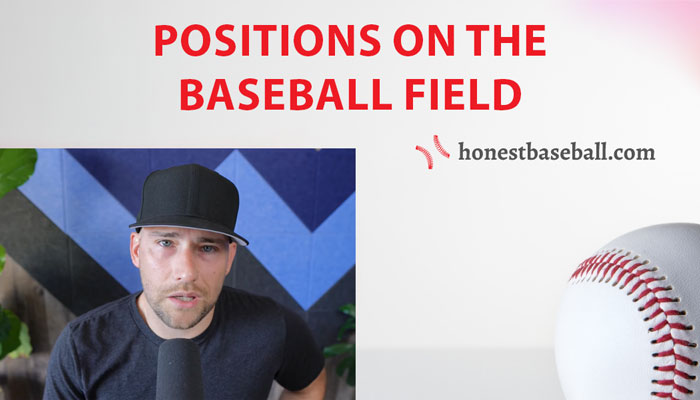For anyone, it can be hazy to understand the positions on the baseball field. And if you are new to this game of baseball then you can get more confused after hearing comments like, “That is a nice delivery for 6-4-3.”
See, positions on the baseball field refer to the different roles that players can play on the team. Each team designs its player’s roles and sets them out in each position. And in this article, I am going to talk about these positions.
Positions in Baseball with the Assigned Number
In a baseball game, there are nine positions. They are as follows:
- Pitcher (P)
- Catcher (C)
- First Baseman (1B)
- Second Baseman (2B)
- Third Baseman (3B)
- Short Stop (SS)
- Left Field (LF)
- Center Field (CF)
- Right Field (RF)
Now I’ll give you a quick rundown of each Baseball position.
Arrangement of Some Basic Baseball Positions
The primary Baseball position is changed based on game demand. As a result, there are primarily four types of arrangements. And these changes only affect infield positioning.
- Standard Infield Depth
- Infield In
- Double Play Depth
- Infield Halfway
Now I’ll go over these briefly to get the most basic idea of the Baseball position.
Standard Infield Depth
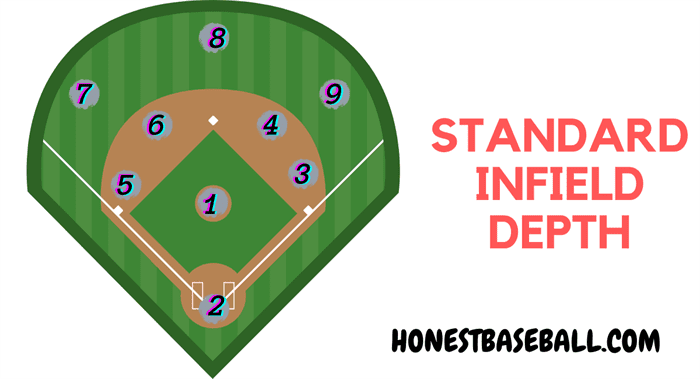
In this strategy, the first baseman and the third baseman keep away from the grass line with a fair distance. On the other hand, the shortstop and second baseman keep the second base right in the middle of them. And this can vary depending on the hitter’s and fielder’s arm strength.
Infield In
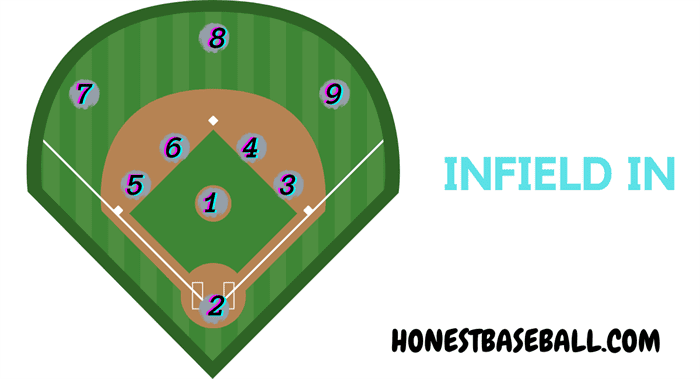
All four infielders are positioned near the grass line. And the distance between the first and second basemen is reduced, as is the distance between the shortstop and third baseman.
Double Play
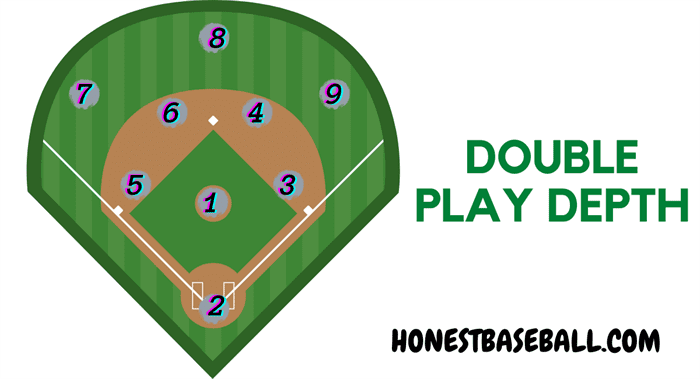
The first and third basemen use this strategy to get closer to their bases and the grass line. On the other hand, the second baseman and shortstop positioned player keeps almost equal distance from the second base.
Infield Halfway
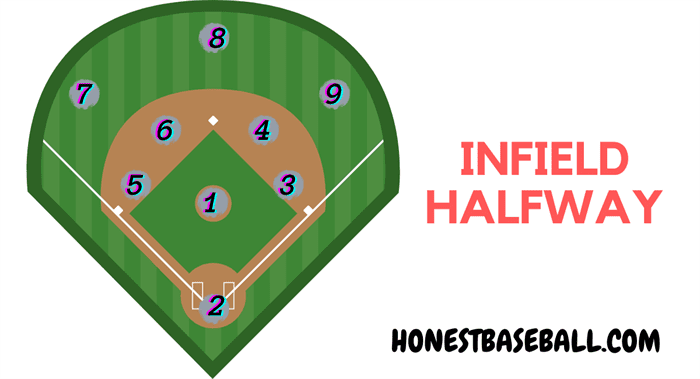
This way, the shortstop and the second baseman reduced the distance from the second base. But also keep a fair distance from the grass line. And the first and third basemen come within touching distance of the grass line.
It would be best if you now understood what 6-4-3 Double plays mean.
This means that, when the hitter hit the ball, it went to the shortstop (6) position. And without a doubt, the shortstop (6) positioned player fields it. Then he throws it to the second baseman (4). And finally, the second baseman (4) may put out a runner and throw it to the first baseman (3) or just directly throw it to the first baseman (3).
Now, why not tell me what a 5-4-3 Double play means in the comment?
If you are still confused about double play, watch this video
Do you want to cheer on your favorite team but do not know how, we have the best solution for you|| How to cheer your favorite team
Pitcher

A pitcher is an essential member of any baseball team. The game primarily depends on them as they control the ball. They are positioned on a pitcher’s mound in the center of the infield.
The pitcher’s responsibility is to keep the batter from scoring. In addition, the pitcher must cover the first base and prevent base runners from extending or stealing bases.
A Pitcher’s Guide to the Rules
- While the pitcher throws the ball he must touch the rubber plate of the mound with one foot.
- He must shoot the ball within the strike zone.
Pitcher Characteristics at a Glance
- A pitcher should have strong throwing arms and legs with a thick lower half and broad shoulders. On average, MLB pitchers are over six feet.
- Mentally tough. So that the pitcher can handle high-pressure situations.
- A reasonable control over the body and throwing mechanics.
- He must have a competitive mind with a strong focus on the game.
Types of Pitching
Pitchers are mainly separated into two categories. Right-Handed and Left-Handed. And they can present various types of pitching. Such as:
- Sinker
- 4 Seam Fastball
- 2 Seam Fastball
- Knuckleball
- Curveball
- Slider
- Cutter
- Rare Eephus
- Change Up
To know the difference between a Curveball and a Slider, follow this link|| Curveball vs Slider
Any of the pitching styles can be used by an experienced and elite-level pitcher. If a pitcher can throw any type, it will be difficult for the batter to execute the perfect swing. As a result, the chances of hitting are reduced.
You might believe that right-handed and left-handed pitchers have the same level of advantage because they have almost the same number of awards in the MLB series. But in most cases, left-handed pitchers get awesome pitching benefits during the game.
A Left-Handed pitcher’s throw is more challenging to hit perfectly. Every hitter is kind of used to facing a right-handed pitcher. So, when they are defending them from a left-handed pitcher, that makes them a little uncomfortable. And this discomfort reduces the hitter’s performance.
A left-handed pitcher’s other feilding advantage is he can easily block an attempt of stealing a base. For a right-handed pitcher, it is tough to keep a runner on first base, because he will need to pivot his entire body to do so. And this delay will give the runner enough time to return to the starting point.
On the other hand, a Left-Handed pitcher is always facing first base. As a result, stealing a base is difficult.
Types of Pitchers and Their Responsibilities
There are mainly two types of pitchers.
- Starting Pitchers
- Relief Pitchers. And this has 4 categories. Long, Middle, Setup, and Closer.
A starting pitcher pitches from the first inning until relieved by a relief pitcher. A starting pitcher can throw a perfect match by allowing no hits, runs, or walks. They can sometimes pitch the entire game.
A starting pitcher has an excellent command of the strike zone and various throwing styles. However, if he becomes tired, the relief pitcher comes in and takes his place.
A long relief pitcher enters the game when a starting pitcher fails to complete the first few innings. This can also occur if the starting pitcher needs to conserve energy for the next game.
Then there’s the middle reliever. This pitcher typically enters the game before the final two innings and does not pitch for more than three innings.
The setup and closer relief are nearly identical. The format keeps the team’s lead from the second to the last innings. And the closer tries to get the game’s final three outs and wins the game.
If a setup relief succeeds, he receives a “Hold” stat, and if a closer achieves, he earns a “Save” stat.
Some Notable Pitchers
Do you know how pitchers increase their pitching velocity? To know the magic read this article|| How a pitcher increase throwing speed
Catcher

The catcher is the most physically and mentally demanding player after the pitcher. And his position is behind the plate, known as the most challenging position.
A catcher must be quick because he must collaborate with the pitcher. A catcher must be able to deal with the heat and squatting all day. They contribute to both the offensive and defensive sides of the game. Most importantly, they are the team’s leaders on the field.
A Catcher’s Guide to the Rules
When the pitcher throws the ball, the catcher must be in the box, which is directly behind the hitter’s plate.
Catcher Characteristics at a Glance
- Taller and more athletic bodies are in high demand in Major League Baseball. They must be long-lasting, strong, and stoker. So they can cover more ground. This is why tall players are becoming a popular choice to fill up this position.
- The catcher’s arms must be both strong and flexible. Fast feet and excellent blocking techniques are also required. This will aid in the development of fantastic receiving techniques.
- Additional benefits include a more focused mind and a larger body.
Catcher’s Responsibilities
- The pitches must be indicated to the pitcher by the catcher. This means that the catcher instructs the pitcher on which pitch to throw and where to throw it.
- He must catch and block pitches like a fortress.
- Receive pitches by framing the ball. So a borderline pitch looks like a strike to the umpire.
- They should be aware of base runners so that the catcher can throw the ball during a runner’s attempt to steal.
- The catcher should also develop a good rapport with the pitcher to improve coordination.
A catcher’s knee is constantly under pressure because of squatting and the blow from a foul ball. So, on average, a catcher appears in only 140 of the 162 games.
Because of the high physical demands, most catchers change positions to extend their careers. Otherwise, due to physical stress, their career span will be limited.
A catcher’s primary role in a game is defense. As a result, their overall batting statistics are the lowest.
If you want to learn more about A Catcher, follow this article|| How to Play Catcher
Some Notable Catcher
The First Baseman
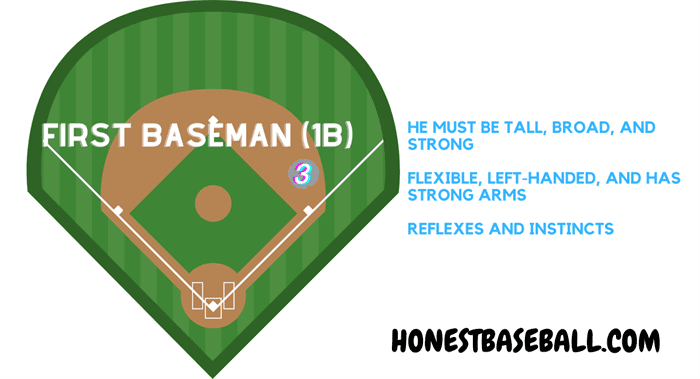
First Baseman is the most demanding position after the pitcher and catcher. The first baseman is the player who is the closest to the first base. As a result, He can cover more ground and reach first base on a ground ball.
When a batter hits a ball and an infielder fields it, the best chance is that the fielder will throw it to the first baseman to get a force out. Because the majority of force-outs occur at first base. Furthermore, the first baseman has the most put-outs.
This is known as the most precise position among all, but this position’s offensive demand is getting higher.
A First Baseman’s Guide to the Rule
A first baseman’s position can change depending on the game, but he must always be close to first base.
First Baseman’s Characteristics at a Glance
- He must be tall, broad, and strong.
- If he is flexible, left-handed, and has strong arms, he will have an additional advantage.
- He must possess reflexes and instincts because balls travel quickly to first base.
- This position may be simple if you want to play at an average pace. But if you’re going to improve, it will not be easy. You will need strength as well as speed.
First Baseman’s Responsibilities
- When a batter hits a ball, his priority is to run to first base.
- He must collect the bad throws.
- To get outs on most throws, he must read the throws.
- A first baseman is also in charge of crashing down-to-field bunt attempts.
- He must do everything to keep the runner at first base. And can get the ball from both the catcher and the pitcher.
You will have a significant advantage if you are a left-handed first baseman. Because throwing a ball to the second base is a bit time-consuming for a right-handed baseman. Because he will have to pivot his entire body to throw the ball.
On the other hand, for a left handed first baseman it will be easy. Because he is already facing second base.
A first baseman’s overall batting stats are very impressive. If a first baseman gets a force-out, he earns the “Put Out” stat.
Some Notable First Baseman
Second Baseman
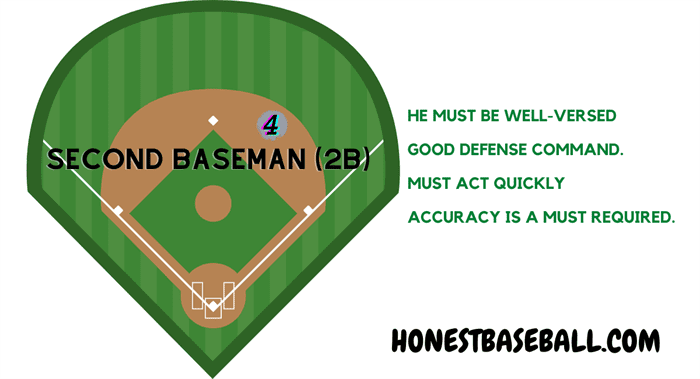
A second baseman stands closer to second base but in general, he plays between first and second base. He stands on the opposite side of the pitching mound, and he can cover the infield’s middle-right side. A second baseman is regarded as a great defensive player on the field.
Fielding a ground ball from going outfield is the primary responsibility of the infielders. And to do so, a second baseman must first understand the batter. The second baseman comes near second base when the team is playing against a right-handed hitter. If the batter is left-handed, the second baseman must stand directly between the first and second base.
A Second Baseman’s Guide to the Rules
A second baseman is not subject to any special rules. He needs to stay between first and second base. Also, keep the ball from going outfield.
Second Baseman’s Characteristics
- The second baseman must be agile and quick.
- He must be well-versed in the game’s rules of receiving and throwing mechanics.
- He should have a good defense command.
- He does not have to be very tall or wide. A player under six feet tall can fill this position.
- He must act quickly because he is in the infield and must keep the ground ball from going out of bounds, regardless of how difficult it is.
- Strong arms are not required, but they are a significant advantage. Because he will be almost in the middle of the ground, there will be no need to throw long.
- Accuracy is a must required.
Second baseman’s Responsibilities
- His first duty is to field every ground ball within his radius.
- Second baseman covers in between the areas of the first and second base.
- If a steal attempt is made, he must cover second base.
- He must also pivot faster than other position players because he may need to pitch to first or third base at any time.
Did you know that the majority of MLB second basemen are right-handed? This is because they must throw the ball to first base most of the time. And if he’s right-handed, he’ll be facing first base naturally. Nonetheless, they can accomplish this without turning the entire body, which is very effective.
Their overall batting performance is second to last in terms of slugging percentage and third in batting average. Every team’s second baseman earned 20 home runs on average during the 2019 season.
If a steal attempt is made, he must cover second base.
He must also pivot faster than other position players because he may need to pitch to first or third base at any time.
Some Notable Second Baseman
The third baseman
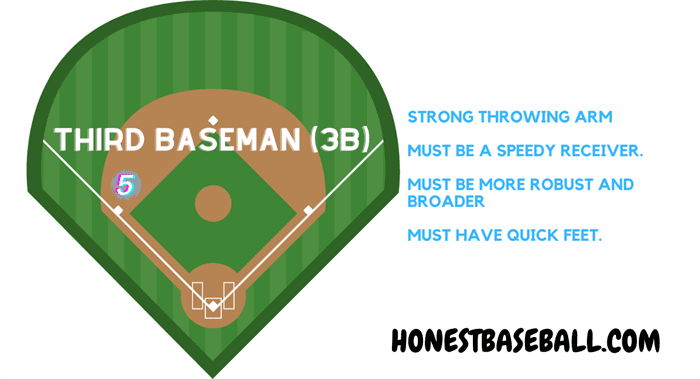
This is also known as the “Hot Corner.” Because a baseman faces the hardest batted balls here, and he is the fielder closest to home plate. A third baseman stands near the third bae keeping a few feet distance from its back to a bit left side (Just like the first baseman takes his position).
A Third Baseman’s Guide to the Rules
Again, unlike pitchers and catchers, third basemen are not subject to any special rules. The third basemen just need to stand near the third base and help the shortstop position player to cover the area.
Third Baseman’s Characteristics
- He requires a strong throwing arm because he must make long throws.
- The third base area is the hot corner because most balls that land there are hard batted balls. As a result, he must be a speedy receiver.
- A third baseman must be more robust and broader than a shortstop. It is preferable to be over six feet tall with solid legs and an upper body.
- He used to be quite large, which was a good thing. However, this is not required.
- Because the first base is so far away, a third baseman must have quick feet.
Third Baseman’s Responsibilities
- He, like other infielders, does not have many responsibilities because most runners are unable to reach third base.
- He only needs to cover the area around third base.
- It is best to stand near the foul line if the batter is right-handed. If the batter is left-handed, it is best to leave some space near the foul line and move towards second base.
- He’s supposed to field ground balls, line drives, and pop flies.
During the 2019 MLB season, every team averaged 28 home runs from third basemen. In addition, the third baseman had the highest slugging average, and the third baseman had the most out hits during the same season.
Some Notable Third Baseman
Shortstop

This is the most contentious defensive position on the baseball ground. A shortstop positioned player usually stands between the second and third base. And maintain a close distance to the second base.
A shortstop is the team’s most defensively capable player. He must also be thoroughly knowledgeable about the game to assist other team members.
They are usually the team’s best fielder, with excellent range and accuracy.
The Shortstop’s Characteristic
- He must have a strong throwing arm and good glove skills.
- A firm grasp of the game and understanding of the player’s movements.
- He must have a solid mentality to deal with pressure and help to lead the team without interruption.
- He needs to be like the elite category athletes who can do anything.
- His average height ranges from 5’10” to 6′.2″.
The Shortstop’s Responsibilities
- Shortstops are considered the infield’s anchors. They are expected to do more than keep the ball from going outfield.
- This player must understand the game and every player’s movement because he must assist other players and assist the catcher in taking the lead.
- In double plays, he is a great help to the second baseman. He can also assist the outfielders by acting as a cutoff man.
- A shortstop position player serves as a bridge between the infield and the left side of the outfield. And that is why it is more important than other positions.
- They must field ground balls from second base and to the right.
Almost every player at shortstop is right-handed. A shortstop positioned player mostly throws the ball to the first or second base. For a left handed \shortstop player, the throwing can be a bit tough and time consuming. Because he needs to pivot his body to throw the ball.
On the contrary, a right handed shortstop player will make the throw easily. As he is already facing the direction.
In the 2019 season, their overall batting average is the second-lowest, with 22 home runs per team.
Some Notable Shortstop Player
Left Fielder
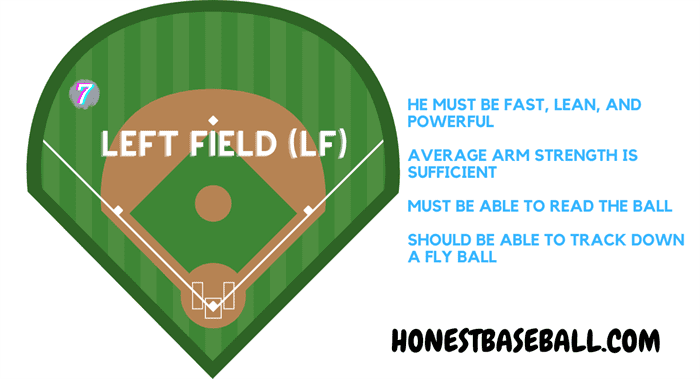
This is a position in the outfield. A left fielder takes a stand behind the third base keeping a long distance. This left-field position is also referred to as “The Outfield Corner.” Because they cover the areas close to the foul line, including the line that touches the wall.
The left fielders typically are known as the “Corner Outfielder.”
Sometimes it’s difficult to distinguish between the left and right fielders. Always look at the field through the eyes of a batter. Then on the hitter’s left is the left fielder’s position and on his right is the right fielder’s position.
Left Fielder’s Characteristics
- He must be fast, lean, and powerful because he must cover much ground. Above all, he should not be a burner.
- It is preferable to be taller than six feet.
- Average arm strength is sufficient for a left fielder.
- If the baseball team has an elite-level center fielder, the left fielder can be below-average fielding ability.
- However, in major league games, the left fielder must be able to read the ball. And must compensate for any deficiencies during batting.
- Overall, he does not need to be a top-tier player. However, he should be able to track down a fly ball as the left-field is busier than the right field.
Left Fielder’s Responsibilities
- This left fielder is the least demanding of the group, despite covering much ground.
- He must throw some balls to third or second base, depending on the situation.
- He serves as the second and third baseman’s backup receiver in the left field.
- He must keep the balls from flying away and do his best to catch any fly balls that come close to him.
On average, every baseball team received 27 home runs from left fielders during the 2019 season. And the hitting quality is over the average of a left fielder. They are usually hard hitters or power hitters.
This is the perfect spot for a team to hide their weakest player.
Some Notable Left Fielders
Center Fielder

A center fielder needs to cover a bigger ground on the Baseball field than other players. That is why a coach or the team manager sets the fastest player to this position.
A center fielder usually stands behind second base, in the outfield’s center. This is the active part among the other outfield positions.
They command the outfield due to their exceptional defensive abilities. They are also known as the outfield’s “Quarterback.”
A center fielder, in short, covers much ground around them. He covers the entire field between the right and left fielders. Also, cover the back of the second base. He also serves as a backup if the other two outfielders can not perform their best.
A Center Fielder’s Guide to the Rules
There are no hard and fast rules to follow, but he will be given the preference to catch or receive any ball because of his skill set.
Center Fielder’s Characteristics
- This is one of the most important defensive positions. Since he has much ground to cover, he must be an excellent fielder.
- He must have been a perfect combination of lean, flexible, quick, and solid for his body.
- To be an elite center fielder he must have a strong arm.
- Height range is not required, but being over six feet tall is preferred.
- He needs to be able to read the ball, which can amplify others’ defensive skills.
- He must quickly return the ball to the required base to prevent the runner from advancing further.
- Overall, center fielders must be top-tier members of the Baseball team.
Center Fielder’s Responsibilities
- He places a higher value on receiving the balls. If more than one player goes for the same fly ball or line drive, the center fielder will have first dibs.
- A center fielder is also in charge of making backup throws to second base. In addition, they catch more fly balls than other fielders.
- Since a center fielder must cover more ground, he is expected to assist his teammates.
Every team received an average of 23 home runs from their center fielders during the 2019 season.
Some Notable Center Fielders
If you want to know about the greatest Baseball players of all time, read this article|| 100 Greatest players
Right Fielder
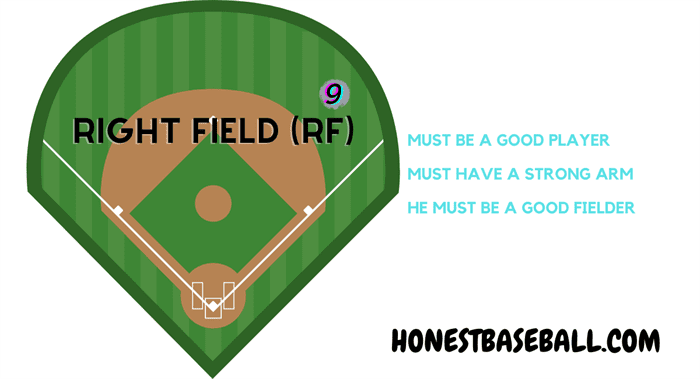
Another outfield position is a right fielder. In Little League, the coach usually assigns this position to the weakest player. This, however, does not occur in Major League Baseball.
Because most baseball players are right handed hitters, this is where the fewest balls land. However, a right fielder needs to cover lots of ground.
He is usually known for his batting ability rather than his fielding ability.
Right Fielder’s Characteristics
- A right fielder in Little League can be a below-average player. Nevertheless, a right fielder must be a good player at the college or professional levels.
- He must have a strong arm. He may need to throw to third base.
- He is typically a power hitter and good at bat.
- He must be a good fielder, but not necessarily like the center fielders or shortstops.
- A substantial body and over six feet of height are required.
Right Fielder’s Responsibilities
- Because the first base is the most active zone, a right fielder must be extremely cautious of this position because he is the first baseman’s backup. If he misses a ball, he must retrieve it and throw it back as soon as possible.
- Like the other outfielder, a right fielder must cover much ground to keep the ball from going further.
- If he goes for a fly ball, he must also be aware of the center fielder’s approach.
- A right fielder must communicate with the center fielder and assist the first baseman.
During the 2019 season, every team’s right fielder hit 29 home runs on average. In addition, right fielders are improving their fielding skills compared to the past.
Some Notable Right Fielders
Do you know which is the hardest position in Baseball, we might have the answer for you in this following article|| Hardest Position in Baseball
Frequently Asked Questions
1) Which position is best for a young player?
ANSWER: As you can see, it depends entirely on your strength and body ratio. You can play in the shortstop or first baseman position if you have the power and height. On the other hand, if you believe you are a competent player, you can select the proper outfield position to play in. It is preferable to explore for weeks before securing a place.
However, playing shortstop at the very beginning can be tough for a young player.
2) Which position in baseball is the most difficult for a player to play?
ANSWER: It is entirely dependent on the individuals and their ability to adapt. For example, if you are supposed to play in the first baseman position but are instead going to play center field. If you can adjust to the post, it will no longer be the most difficult for you. And it will be the most difficult for you if you can not change to it, even if it is the right outfield position.
Some fielding positions require a combination of two or three skill sets. Other places may necessitate additional qualifications. If you have the necessary skills, you will be able to handle the position with ease.
3) Which position demanded the strongest arms the most?
ANSWER: I suppose right-fielders have the most robust arms than any other positioned players. Because he mostly needed to throw the ball to third base, which is quite far away.
4) Which position in baseball is considered the easiest?
ANSWER: The right fielder position is easiest than other positions. Because most batters are right-handed, fewer balls reach the right side of the outfield.
5) Is it possible to switch positions in a baseball career?
ANSWER: It’s not impossible. But it takes a lot of effort. Suppose you played the shortstop position but want to switch to center field. Then you must build yourself in that manner to adjust to your new position.
Now you know everything about fielding position, why not learn about the basic rules|| Basic Rules of Baseball
Conclusion
Old days of baseball have changed a lot over the years, but the positions of the players remain the same. However, strategies were developed for each position. With those new options, we now have modern Baseball.
Each field position required a distinct set of skills and qualifications. Every player is improving their ability to carry out their responsibilities. And each component improves in efficiency and effectiveness.
And if you want the best position, do not just choose in a selfish way. Think of your team and then choose. A perfect position for you, which you can handle well. Not where you will have more footage.
Hope you get the idea on positions on the Baseball field.

Hello everyone. My name is Jason Butler, and I live in California, America. I was a professional AAA Minor League Baseball player. I lost my chance of playing MLB for injury issues, but I did not lose my love for baseball. I attended the coaching training program and am now working as a coach in a small school in San Diego.
I always love to share my experience and knowledge if that can help you. Play baseball, and stay fit.
